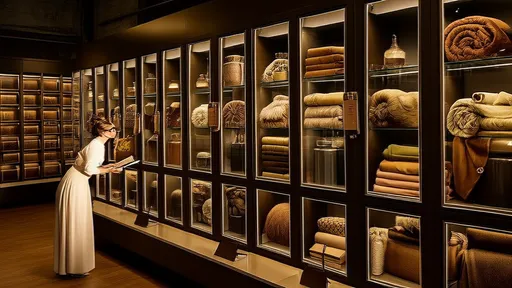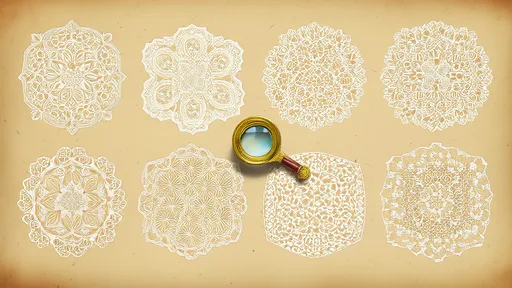The world of antique lace is a mesmerizing tapestry woven with history, artistry, and cultural significance. For centuries, lace has adorned the garments of royalty, the altars of cathedrals, and the homes of the elite. The Antique Lace Digital Archive: 200 Years of Classic Patterns offers an unprecedented glimpse into this delicate craft, preserving the intricate beauty of lacework that has stood the test of time. This digital treasure trove is not merely a collection of images; it is a portal to the past, where each stitch tells a story of craftsmanship, tradition, and innovation.
The archive meticulously documents lace patterns spanning two centuries, from the early 1800s to the dawn of the 20th century. These patterns, once painstakingly created by hand, now find new life in digital form. The collection includes everything from the geometric precision of Venetian gros point to the ethereal delicacy of Chantilly lace. Each piece is a testament to the skill of the artisans who crafted them, often working in dim light with needles finer than a human hair. The digital archive ensures that these masterpieces are not lost to the ravages of time, but rather preserved for future generations to study and admire.
One of the most striking aspects of the archive is its ability to showcase the evolution of lace design. The early 19th-century patterns reflect the neoclassical influences of the time, with symmetrical motifs inspired by ancient Greek and Roman art. As the Victorian era took hold, lace designs became more elaborate, incorporating floral and botanical elements that mirrored the period’s fascination with nature. By the late 1800s, the Art Nouveau movement introduced flowing, organic lines and asymmetrical compositions, pushing the boundaries of traditional lacemaking. The archive captures this dynamic progression, allowing viewers to trace the shifting tastes and techniques across decades.
Beyond its aesthetic appeal, the archive serves as an invaluable resource for historians, textile conservators, and contemporary designers. For historians, the patterns provide insights into the social and economic contexts of their creation. Lace was often a luxury item, its production tied to the rise of industrialization and the global trade networks that supplied the finest threads. Textile conservators can study the archive to better understand the materials and methods used in antique lace, aiding in the preservation of physical specimens. Meanwhile, modern designers draw inspiration from these timeless patterns, reinterpreting them for today’s fashion and decor.
The process of digitizing these fragile textiles was no small feat. Many of the original lace pieces are incredibly delicate, with threads that have weakened over time. High-resolution photography and advanced scanning techniques were employed to capture every minute detail without causing damage. In some cases, photogrammetry was used to create 3D models of the lace, allowing viewers to appreciate the dimensionality of the work—something that flat images alone cannot convey. The result is a digital archive that honors the physicality of the original pieces while making them accessible to a global audience.
What makes the Antique Lace Digital Archive truly remarkable is its democratizing effect. In the past, such treasures were confined to museum vaults or private collections, visible only to a privileged few. Now, anyone with an internet connection can explore these patterns in stunning detail. This accessibility fosters a deeper appreciation for the art of lacemaking and ensures that the knowledge embedded in these designs is not lost. It also opens up new possibilities for collaboration, as researchers and artists from around the world can study and build upon these historical works.
The archive also highlights the often-overlooked role of women in the history of lace. For centuries, lacemaking was a female-dominated craft, providing economic opportunities for women in a time when few were available. The painstaking work required immense patience and skill, and the best lacemakers were highly sought after. The digital archive pays homage to these unsung artists, preserving their contributions to a craft that was as much about survival as it was about beauty. By documenting their work, the archive ensures that their legacy endures.
As we move further into the digital age, projects like the Antique Lace Digital Archive remind us of the importance of preserving tangible history. While lace may seem like a niche subject, it is a microcosm of broader cultural, economic, and artistic trends. The patterns in the archive are more than just decorative; they are threads connecting us to the past. Whether you are a historian, a designer, or simply someone who appreciates beauty, the archive offers a rich and rewarding exploration of a craft that has shaped human expression for centuries.
In a world where fast fashion and mass production dominate, the Antique Lace Digital Archive stands as a counterpoint—a celebration of slow, deliberate craftsmanship. It invites us to pause and marvel at the intricacy of handmade art, to consider the hours of labor embedded in each delicate motif. The archive is not just a collection of patterns; it is a tribute to the human hands that created them and a promise to future generations that these works will not be forgotten. As we click through the digital pages, we are not just observers but participants in the ongoing story of lace.

By /Jul 16, 2025

By /Jul 16, 2025

By /Jul 16, 2025

By /Jul 16, 2025

By /Jul 16, 2025

By /Jul 16, 2025

By /Jul 16, 2025

By /Jul 16, 2025

By /Jul 16, 2025

By /Jul 16, 2025

By /Jul 16, 2025

By /Jul 16, 2025

By /Jul 16, 2025

By /Jul 16, 2025

By /Jul 16, 2025

By /Jul 16, 2025

By /Jul 16, 2025

By /Jul 16, 2025